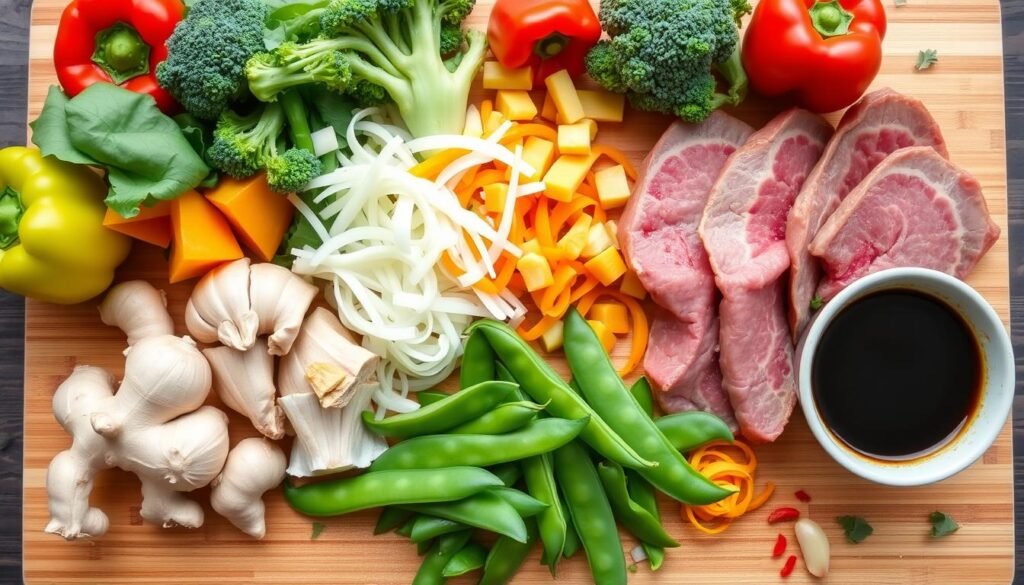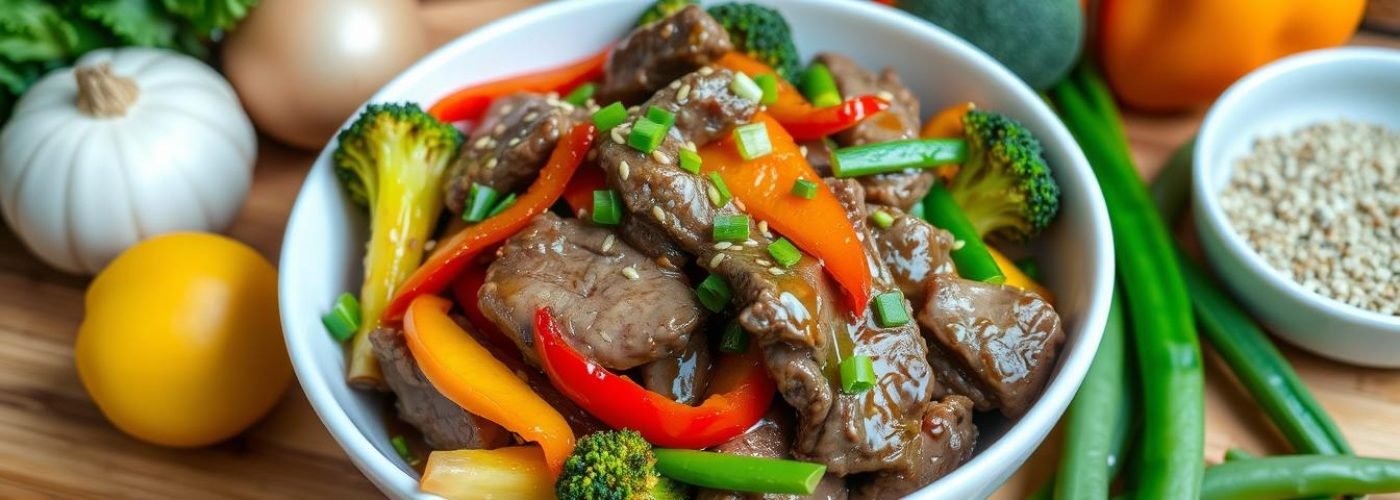If you’re looking for a delicious and nutritious meal that fits seamlessly into your busy lifestyle, look no further than low-fat beef stir-fry. This healthy stir-fry option not only packs a flavorful punch but also delivers a quick dinner recipe that’s perfect for any night of the week. Packed with tender low-fat beef and vibrant vegetables, it caters to health-conscious individuals without sacrificing taste. In this article, you’ll discover a complete recipe, helpful nutritional information, and tips to make your beef stir-fry truly outstanding.
What is Low-Fat Beef Stir-Fry?
Low-fat beef stir-fry is a flavorful dish that features *lean cuts of beef* paired with an array of colorful vegetables. It utilizes the stir-fry cooking method, which involves cutting ingredients into thin slices and cooking them rapidly over high heat. This technique not only preserves the vibrant flavors but also retains vital nutrients from the ingredients while keeping the fat content low.
The definition of low-fat beef stir-fry highlights its health-conscious approach, ensuring that meals remain satisfying without excess calories. This dish is commonly prepared in a small amount of oil, allowing for a delightful blend of tastes and textures, making it a favored option for those pursuing a nutritious diet.
Embracing this style of cooking promotes a quick, efficient meal preparation that fits well into busy lifestyles. Ideal for family dinners or meal prepping, low-fat beef stir-fry offers versatility and ease, appealing to a wide range of palates.
Benefits of Choosing Low-Fat Beef
Selecting low-fat beef as a protein source comes with numerous health benefits. This choice typically includes cuts that are lower in calories and saturated fats compared to higher-fat options. Such attributes make low-fat beef an excellent ally in weight management. Studies indicate that maintaining a diet rich in lean protein can help support muscle maintenance while still controlling caloric intake.
Low-fat beef provides high-quality protein packed with essential nutrients such as iron, zinc, and B vitamins. These components play critical roles in maintaining energy levels, supporting the immune system, and ensuring proper metabolism. Incorporating low-fat beef into meals promotes a balanced diet while contributing to overall well-being.
Whether it’s in a stir-fry, grilled, or stewed, the versatile nature of low-fat beef allows it to fit seamlessly into various healthy eating plans. Choosing this protein source not only enhances meal satisfaction but can also align with health goals, making it a smart addition to any plate.
Key Ingredients for a Delicious Low-Fat Beef Stir-Fry
Creating a mouthwatering low-fat beef stir-fry requires careful ingredient selection to achieve flavor without excess fat. Consider the following essential components that will elevate your dish.
Choosing the Right Cut of Beef
Selecting the right beef cuts is crucial for a low-fat option. Lean cuts such as sirloin, flank steak, or round steak not only provide excellent flavor but also help keep the dish lighter. These cuts are tender, making them ideal for quick cooking methods common in stir-fry.
Fresh Vegetables to Include
Incorporating a variety of fresh vegetables adds both nutrition and texture. Consider vibrant options like:
- Bell peppers
- Broccoli
- Snap peas
- Carrots
- Zucchini
Using a colorful mix not only enhances the visual appeal but also provides essential vitamins and minerals to your stir-fry.
Essential Stir-Fry Sauces
For a flavor-packed dish, incorporate essential stir-fry sauces. Low-sodium soy sauce serves as a great base, while ginger and garlic can add a depth of flavor without compromising health. Just a small amount can enhance your stir-fry, making the dish both delicious and mindful of calorie content.

| Ingredient Type | Recommended Ingredients | Benefits |
|---|---|---|
| Beef Cuts | Sirloin, Flank Steak, Round Steak | Lean, flavorful, tender |
| Fresh Vegetables | Bell Peppers, Broccoli, Snap Peas | Colorful, nutritious, adds crunch |
| Stir-Fry Sauces | Low-Sodium Soy Sauce, Ginger, Garlic | Flavor enhancing, low-calorie |
Low-Fat Beef Stir-Fry Recipe
Creating a delightful low-fat beef stir-fry at home can be both enjoyable and rewarding. This easy stir-fry recipe is perfect for those busy weeknights when a quick dinner is essential. Let’s dive into the ingredient list and low-fat beef stir-fry instructions that will get your meal on the table in no time.
Ingredient List
- 1 pound lean beef (such as flank steak or sirloin), sliced thinly
- 2 cups assorted vegetables (bell peppers, broccoli, and snap peas)
- 2 tablespoons low-sodium soy sauce
- 1 tablespoon cornstarch
- 2 tablespoons vegetable oil
- 1 teaspoon garlic, minced
- 1 teaspoon ginger, minced
- Salt and pepper to taste
Step-by-Step Instructions
- Marinate the beef: In a bowl, combine the sliced beef, soy sauce, and cornstarch. Mix well and let sit for 15-20 minutes.
- Prepare the vegetables: While the beef is marinating, chop the assorted vegetables into bite-sized pieces.
- Heat the oil: In a large skillet or wok, heat the vegetable oil over medium-high heat.
- Sauté the beef: Add the marinated beef to the skillet and cook for about 3-5 minutes, or until browned. Remove the beef and set aside.
- Cook the vegetables: In the same skillet, add garlic and ginger. Stir-fry for 1 minute before adding the vegetables. Cook for an additional 3-4 minutes until tender-crisp.
- Combine: Return the beef to the skillet, stirring everything together until heated through. Season with salt and pepper to taste.
Macronutrient Breakdown of Low-Fat Beef Stir-Fry
Understanding the nutritional breakdown of your meals can significantly impact your dietary choices. Low-Fat Beef Stir-Fry stands out as a nutritious option, particularly due to its compelling macronutrients. By examining the calories in beef stir-fry, one can appreciate how it fits within a balanced diet.
Caloric Content
A single serving of low-fat beef stir-fry typically contains around 300 to 400 calories, depending on the specific ingredients used. This makes it a reasonable choice for those monitoring their caloric intake. Knowing the approximate calorie count allows individuals to plan their meals effectively while enjoying this delicious dish.
Protein, Fats, and Carbs
This dish provides an impressive macronutrient profile. The protein content in low-fat beef stir-fry is particularly high, often consisting of about 25 to 30 grams per serving. This makes it an excellent option for muscle repair and growth. The fats remain relatively low, generally under 15 grams, contributing to its healthful characteristics. Carbohydrates play a vital role as well, usually ranging from 15 to 20 grams, primarily sourced from the vegetables and any rice or noodles included.
Tips for Making the Perfect Stir-Fry
Achieving the ideal stir-fry requires attention to a few essential stir-fry tips that enhance both flavor and texture. Begin with mise en place, preparing all your ingredients before getting started. This method streamlines cooking and ensures that everything is ready to go when you need it.
Utilizing high heat is crucial for stir-fry efficiency. Cooking on high heat allows for a quick cook time, creating tender and flavorful beef while retaining the crispness of your vegetables. It’s all about speed when it comes to these delicious dishes.
A common mistake to avoid is overcrowding the pan. When too many ingredients are added at once, they tend to steam rather than fry. This ruins the delicate texture you aim for. Instead, cook in small batches to allow for proper heat circulation and even cooking.
Consistency in ingredient preparation also plays a significant role. For example, slicing beef against the grain will enhance tenderness. Similarly, cutting vegetables into uniform shapes allows for even cooking, making them more enjoyable to eat.
| Preparation Tip | Description | Benefits |
|---|---|---|
| Mise en Place | Prepare all ingredients before cooking | Streamlines process and prevents delays |
| High Heat Cooking | Use high heat for quick cooking | Creates tenderness and retains crispness |
| Avoid Overcrowding | Cook in small batches to prevent steaming | Ensures even cooking and better texture |
| Consistent Cuts | Cut beef and vegetables uniformly | Allows for even cooking and improved texture |
Variations on Low-Fat Beef Stir-Fry
Customizing your low-fat beef stir-fry can elevate your meals and accommodate different tastes. By exploring stir-fry variations, you can cater to seasonal produce and preferred flavors. Here are some tips to enhance your dish.
Swap Out Vegetables
Incorporating vegetable substitutions can transform your stir-fry. Seasonal veggies like zucchini and asparagus work wonderfully, bringing freshness and different textures. Here are some great alternatives:
- Bell peppers
- Snow peas
- Carrots
- Broccoli
- Snap peas
These substitutions maintain the dish’s nutrition while adding vibrant colors and flavors.
Using Different Protein Options
For those looking to vary their protein sources, consider using alternative proteins like chicken, shrimp, or tofu. Each option offers unique flavors and textures while keeping the meal low-fat. Experimenting with these can change the entire profile of your dish:
- Chicken – Lean and easy to pair with sauces.
- Shrimp – Quick-cooking and delicious when sautéed.
- Tofu – A fantastic plant-based option that absorbs flavors nicely.
By trying these variations, you’ll keep your meals exciting and flavorful.
Cooking Equipment Needed for Stir-Fry
To achieve the perfect stir-fry, having the right cooking equipment is essential. The following list highlights some of the key stir-frying tools and necessary equipment every home chef should consider:
- Wok or Large Skillet: A wok distributes heat evenly, making it ideal for quick cooking at high temperatures. A large skillet can also be used if a wok is unavailable.
- Spatula: A sturdy spatula is crucial for tossing ingredients swiftly without burning them.
- High-Heat Oil: Using oils with high smoke points like peanut or canola oil prevents burning and adds depth to flavor.
- Good-Quality Knife: A sharp knife simplifies cutting vegetables and meat into uniform pieces, ensuring even cooking.
- Stovetop: A stovetop with sufficient heat output is necessary for achieving the searing effect associated with authentic stir-fry.
Investing in quality kitchen essentials is a smart move for any culinary enthusiast. The proper stir-frying tools streamline the cooking process, making it faster and more efficient.
| Equipment | Purpose |
|---|---|
| Wok | Even heat distribution for cooking quickly |
| Spatula | Facilitates tossing ingredients |
| High-Heat Oil | Prevents burning and enhances flavor |
| Knife | Allows for precise cutting of ingredients |
| Stovetop | Provides adequate heat for searing |
How to Store and Reheat Leftovers
Storing leftover stir-fry properly is crucial for maintaining flavor and ensuring food safety. Following best storage practices can prolong the freshness of your meal and make it easier to enjoy later. Here are some effective tips for food storage and reheating your leftover stir-fry.
Best Storage Practices
To achieve optimal flavor and safety when storing leftover stir-fry, consider the following steps:
- Use airtight containers to minimize air exposure.
- Cool the meal within two hours of cooking before transferring to the refrigerator.
- Label containers with dates to keep track of freshness.
Reheating leftover stir-fry can be straightforward, but employing the right methods will enhance the overall experience. Here are some effective reheating tips:
- Microwave: Place the stir-fry in a microwave-safe container, cover it loosely, and heat for 1-2 minutes. Stir halfway for even heating.
- Skillet: Heat a splash of oil in a skillet over medium heat. Add the leftover stir-fry and cook, stirring frequently, until heated through.
These reheating techniques not only preserve the taste of your leftover stir-fry but also ensure a satisfying texture. Proper food storage and reheating methods will help you reduce waste and enjoy your meal to the fullest.

Testimonials and User Experiences
Many individuals have shared their user feedback on the Low-Fat Beef Stir-Fry, highlighting its delicious taste and ease of preparation. One enthusiastic home cook mentioned how they appreciated the simplicity of the recipe, stating, “I never knew a stir-fry could be so fulfilling and still fit into my healthy lifestyle!” This sentiment is echoed in several beef stir-fry reviews, where users praise the balance of flavorful ingredients without the guilt of excessive fat.
Cooking experiences with this dish often involve personal twists that cater to family preferences. For instance, some users enjoy experimenting with different vegetables based on seasonal availability, while others enhance the flavors with their favorite sauces. These modifications not only keep the dish exciting but also allow individuals to make it their own, fostering a sense of creativity in the kitchen.
With its positive reception, the Low-Fat Beef Stir-Fry has become a staple for many looking to maintain healthy eating habits. Users frequently express how this meal seamlessly fits into their routine, making it a go-to option for busy weeknights. Engaging with the community through these shared stories has only amplified interest in trying the recipe, reinforcing its status as a beloved choice for health-conscious food enthusiasts.

